Share

Invisible Not Broken - Chronic Illness Podcast Network
Thoracic Outlet Syndrome, Spoonie Business Owners, Pain Management, & Relationships Chronic Illness Edition
Sign up with your email address to receive news and updates.
Email Address Sign UpWe respect your privacy.
Thank you!This week we’re talking about the Thoracic Outlet Syndrome with Jen Hein and I have been waiting a long time for this episode because I really want to talk to another person who has a chronic illness and had to close of business that they built. Some of you know that I also had to shut down my Menlo Park photography studio when my Ehlers Danlos became too severe to continue. We talked about everything from pain management, medical marijuana in California, the opioid crisis has always been a big one here, and getting on drug seeking lists when accessing pain medication, and the kind of behavior you have to show to be a "good" patient. Listen to the very end because we talk about what it’s like for spoonies to be in a relationship together, we talked about sex and disability (check out Kyros and my panel discussion about chronic illness and sex and relationships here), and we talk about some really good ideas for romantic low-stress spoony dates.
If you would like to contact Jen you can find her on Instagram at rebel__lioness
Recommendations and LinksA Better Pain Scale Hyperbole and A Half
Acupuncture and Thoracic Outlet Syndrome
Spoonie & Spoonie Relationship Advice1) This is probably the most important one: having massive patience, understanding, and flexibility with each other. Pain does not work on a timeline, and neither can we. These are all skills and practices that take time.
2)Teamwork cooking. We decide what we want to eat for dinner based on our pain level and what we are able to do. Then we help each other make the dinner. Some nights it’s “tap out” style. Like, I can’t keep cutting/doing this anymore, you’re up! We also cook things that are easy to make, often even prepared foods. We use paper plates, and plastic cups (it kills me inside to make waste, but dishes aren’t a thing either of us can do anymore).
3) Having a plan before we do anything. Cooking, going to the store, leaving the house for a doctors appointment, etc. Take the time to plan out what you will both realistically need before you start the activity/outing.
4) Divide and conquer the chores. Decide what each of you can realistically do, what you cannot do, and what you can do together as a team. Despite the fact that both my partner and I have pain in our hands and arms, we manage to get most of the chores done around the house. Of course the deep cleaning is out of the question for us, but we are lucky enough to have friends and family that help us with that when we need it.
5)Take a day just to relax. This is really important to avoid complete burnout. We try to do this on Sundays. It doesn’t always work out, but at least try. To us, this means a day where neither one of us have to do anything physical to anger our pain. It also means a day where we don't talk too much about doctors appts/frustrations, etc. A true day off for your mind and body. A guided meditation is great way to start that off (I use a wonderful app called Insight Timer).
What is your disorder? *
Thoracic outlet syndrome. I also have scoliosis, myofascial pain syndrome, and chronic pain (Love that one, such a blanket term)
Do you have any life hacks? *
Definitely yes. I use electric everything possible in the kitchen, can openers etc. I have a stool and every room so I can reach up to high places without having to lift my arm over my head. I have plastic cups and paper plates, which I hate because of the waste, but have to do because I am unable to do dishes. I keep things that I need on an accessible shelf instead of in a drawer or cabinet. I only use speak text is I cannot type. I have many pillows that I use for various things, for example, I have to use a pillow on each side of me while in the car to prop up my arms. I wear a scarf most of the time to keep my neck warm so it doesn’t flare up. I live in Yoga Pants and a tank top off my left shoulder, bras are never coming back into my life. Wireless headphones for my phone, so I don’t have to hold it. I’m sure there’s more. Meditation is high on the list for sure. I also use medical cannabis, which helps. I do therapy weekly. When I’m in a flare-up, I find my best coping mechanism is distraction. TV, podcasts, music, or taking a walk. In the rare days I’m not flared up, I’m usually OK with a set of tools that I have kind of created for myself.
Is there anything you want to make sure we talk about during the interview? Like an organization you want to promote or something specific that you deal with.
Basically just promoting awareness about TOS. I am a member of a few Facebook support groups that have really helped me, and I would like to spread the word about that if people don’t already know.
What is the hardest and/or best lesson your condition has taught you?
Patience
What is the best purchase under $100 that helped your life
It’s a tie between my wireless headphones and my golden tiger topical
More episodes
View all episodes
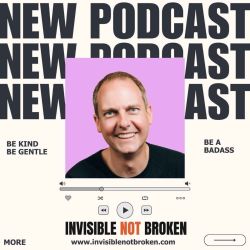
Vulnerability, Resiliency, and Advocacy with Tim Reitsma
47:06Monica Michelle is joined by consultant and podcast host Tim Reitma.Tim lives with Crohn's Disease.In this episode, Monica and Tim discuss: Tim’s resiliency through managing his Crohn’sThe importance of self-advocacy, especially in the workplace Tim’s podcast why he shares stories of those with invisible illness TIMESTAMPS00:47 - Tim's diagnosis 06:31 - How and why Tim applies self advocacy15:41 - Why Tim started his podcast22:42 - Invisible condition etiquette31:00 - What HR can do better for employees with invisible illness39:31 - Tools Tim uses to care for his Crohn’s outside the homeThe full transcript and all links mentioned can be found on the episode page on invisiblenotbroken.com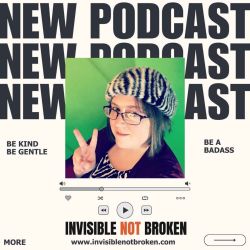
Tech and Disability: What VR Offers the Disabled Community with Sunny Ammerman
01:10:27Monica Michelle is joined by artist and disability advocate Sunny AmmermanSunny lives with Septo-optic dysplasia, panhypopituitarism, Optic Nerve Hypoplasia, and is missing a membrane in the brain called the "septum pellucidum".In this episode, Monica and Sunny discuss: Sunny’s complex disorders and how she copes with themEverything VR provides from accessible gaming, social platforms and the potential for better online education.Various VR/AR games and their gameplay Sunny’s VR support groupTIMESTAMPS00:45 - What VR/AR offers for chronically ill and disabled folks11:57 - Sunny’s conditions and how she copes with them17:55 - Features that make VR games accessible or inaccessible as well as different games and their play experiences37:13 - The social aspects of virtual gaming51:32 - What opportunities VR has for the future1:04:49 - Sunny’s VR support group The full transcript and all links mentioned can be found on the episode page on invisiblenotbroken.com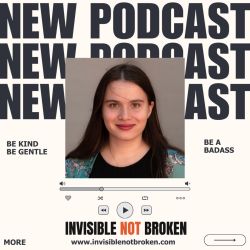
Reporting on Chronic Illness and Disability with Journalist Julia Metraux
39:16Monica Michelle is joined by Journalist Julia Metraux.Julia lives with vasculitis, mild to moderate hearing loss, and has experienced long COVID.In this episode, Monica and Julia discuss: Julia's diagnosis with vasculitis and how it influences her journalistic lensHow community impacts the mental health of those with chronic illnessHow Julia and Monica find positives and negatives in the internet spaces for chronically ill and disabled folksThe politics of how government, businesses, and celebrities influence the chronic illness community TIMESTAMPS00:32 - Julia's diagnostic journey07:02 - Julia’s work reporting on the online community of chronic illness 16:32 - The effect of Internet communities on chronically ill and disabled folks26:46 - How Julia’s illness impacts her work, both in what she writes about and how she manages her lifestyleThe full transcript and all links mentioned can be found on the episode page on invisiblenotbroken.com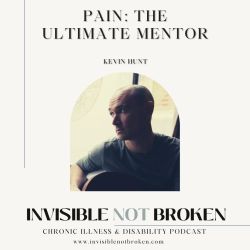
Author of “Pain: The Ultimate Mentor,” Physiotherapist Kevin Hunt
31:29Monica Michelle is joined by author & physiotherapist Kevin Hunt.Kevin lives with chronic pain.In this episode, Monica and Kevin discuss: Kevin’s philosophy of pain management as a physiotherapist who experiences chronic pain. The Hexagon Model, a life-management tool for focusing on what’s important to you.Kevin’s idea behind his new book.Using pain as a guide.TIMESTAMPS00:34 - Kevin’s work as a physiotherapist specializing in the experience of pain 06:44 - The Hexagon Model for managing your life’s needs14:00 - Putting aside the idea of a “quick fix”19:45 - Kevin’s personal experience with pain and how he uses it with patients28:44 - Kevin’s book, “Pain: The Ultimate Mentor”The full transcript and all links mentioned can be found on the episode page on invisiblenotbroken.com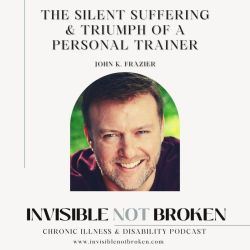
Author of “Through the Pain: The Silent Suffering & Triumph of a Personal Trainer”: John K. Frazier
28:35Monica Michelle is joined by author & personal trainer John K. Frazier.John lives with ankylosing spondylitis.In this episode, Monica and John discuss: John’s work as a physical trainer and authorChronic pain comparisonsPersonal triumphTIMESTAMPS00:50 - John’s business & diagnosis07:19 - Chronic pain olympics09:31 - Talking about & hiding a diagnosis15:09 - Personal triumph18:24 - Staying in the present23:29 - The superman complexThe full transcript and all links mentioned can be found on the episode page on invisiblenotbroken.com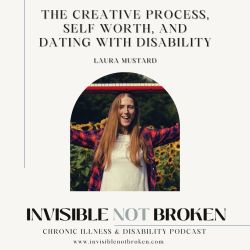
The Creative Process, Self Worth, and Dating with Disability: Laura Mustard
31:08Monica Michelle is joined by musician Laura Mustard.Laura lives with VATER syndrome.In this episode, Monica and Laura discuss: Laura’s inspiration for her upcoming musical EP.How Laura’s illness impacted her recent relationship & self-image.Laura’s creative process, new music, and social media pressure.TIMESTAMPS00:30 - Laura’s new EP / Monica’s recent COVID experience05:32 - Relationships with chronic illness11:20 - Image and self acceptance with disability15:32 - Laura’s creative process and current projects20:05 - Pursuing creativity despite social media attentionThe full transcript and all links mentioned can be found on the episode page on invisiblenotbroken.com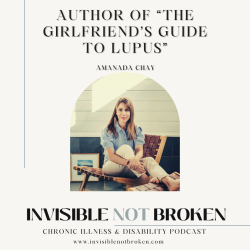
Author of “The Girlfriend’s Guide to Lupus”: Amanda Chay
30:43Monica Michelle is joined by author Amanda Chay.Amanda lives with Sjögren’s and Lupus.In this episode, Monica and Amanda discuss: Amanda’s book & diagnosisOutlooking on work & writingNavigating chronic illness with kids & familyTIMESTAMPS00:26 - Intro + The Girlfriend’s Guide to Lupus02:17 - Amanda’s diagnosis10:09 - Amanda’s outlook on writing17:11 - Navigating chronic illness with kids & family23:29 - Labels and roles26:24 - Flare reads & closing remarksThe full transcript and all links mentioned can be found on the episode page on invisiblenotbroken.com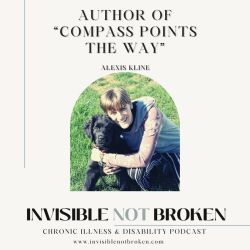
Author of “Compass Points the Way”: Alexis Kline
23:14Monica Michelle is joined by author Alexis Kline.Alexis lives with Dysautonomia.In this episode, Monica and Alexis discuss: Being a sick teenagerHaving an isolated diagnosisProductivity workflowsTIMESTAMPS00:28 - Alexis’s diagnosis & dog07:18 - Sick teenager road map10:00 - Alexis’s book & workflow16:25 - Having an isolated diagnosis20:50 - Wildlife photography, purchases The full transcript and all links mentioned can be found on the episode page on invisiblenotbroken.com
Author of “From the Sidelines to the Finish Line”: Emily Falcon
36:47Monica Michelle is joined by author Emily Falcon.Emily lives with ALCAPA.In this episode, Monica and Emily discuss: Growing up sickPost-surgery supportHaving a public bodySelf-motivation and adventuringTIMESTAMPS00:28 - Being a sick kid & Emily’s book title07:28 - Mortality10:16 - Portrayal of disability in media12:21 - Post-surgery support19:23 - Having a public body23:43 - Self-motivation29:46 - Emily’s tips for adventuresThe full transcript and all links mentioned can be found on the episode page on invisiblenotbroken.com